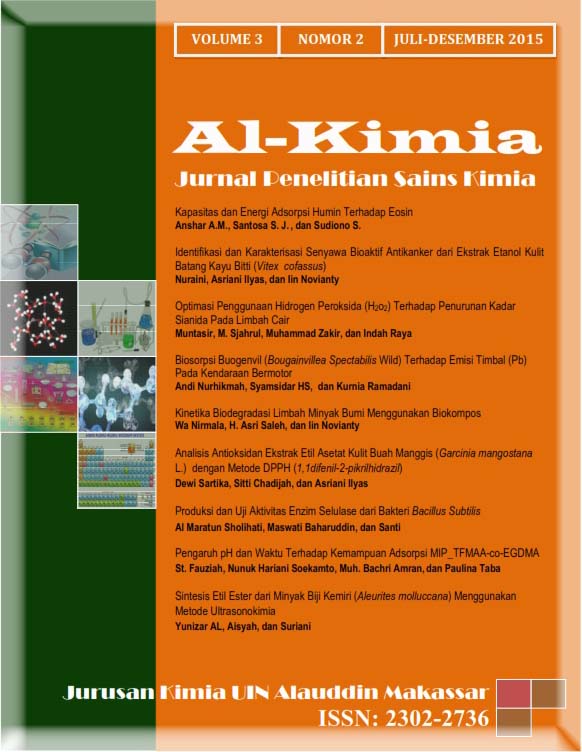Optimasi Penggunaan Hidrogen Peroksida (H2O2) Terhadap Penurunan Kadar Sianida Pada Limbah Cair
Abstract
Optimation studies have been conducted using hydrogen peroxide (H2O2) to the reduction of cyanide levels in the wastewater. Parameters studied were the optimum concentration of hydrogen peroxide (H2O2), the optimum pH and optimum contact time between hydrogen peroxide (H2O2) with wastewater in reducing the cyanide content. Cyanide obtained from steam distillation of liquid waste and the assay using 0.02N silver nitrate. Concentration used were 500 ppm, 400 ppm, 300 ppm, 200 ppm and 100 ppm; pH range is (7, 8, 9, 10 and 11) and the variation of the contact time is: 0, 30, 60, 90, 120 and 150 minutes. The result of the research reveals at early treatment the cyanide content is 50,22% w / w and underwend a reduction in levels after addition of various concentrations of H2O2; variations in pH variation of contact time. Optimum condition treatment at 500 ppm of H2O2 basicity at pH 8 and contact time for 60 minutes result reduction of cyanide level of 36,40% w/w, 40,91% w/w and 37,09% w/w respectively.
Downloads
References
Awan. M. A. 2004. Reduction of Chemical Oxygen Demand from Tannery wastewater by oxidation. (EJEAFChe) Electronic Journal of Environmental, Agricultur and Food Chemistry 3 (1) : 625-628
Botz, M.M. 2001, “Overview of Cyanide Treatment Methods’, Mining Environmental Management, Mining Journal Ltd., London, UK, pp. 28-30.
Cidu, R., Pelo, D.S., Frau. F. 2011. Impact of gold mining on the aquatic system: a case study at Furtei (Sardinia, Italy). Mine Water–Managing the Challenges. IMWA : 575-580.
Dasha, R, R., Gaur, A., Balomajumderb, C. 2009. Cyanide In Industrial Wastewaters and Its Removal: A Review on Biotreatment. Journal of Hazardous Materials 163 : 1–11.
Dash. R. R., Balomajumder. C., Kumar. A., 2009. An Overview of Removal Methods of Cyanide from Industrial wastewater. The International Congress on Civil Enginering.
Deveci, H., Yazıcı, E.Y., Alp, I., Uslu, T. 2006. Removal of Cyanide from Aqueous Solutions by Plain and Metal-Impregnated Granular Activated Carbons. Int. J. Miner. Process. 79 : 198–208.
Hidayat, D. 2011. Pengaruh Sianida Pada Fotoreduksi Hg (II) yang Dikatalisis TiO2. Molekul, 6. (1).: 40–45.
Hidayati, N., Juhaeti, T., Syarif, F. 2008. Potensi Hiperakumulasi Saccharum spontaneum Pada Medium Limbah Tailing Terkontaminasi Sianida. Biota. 13 (2): 97-105.
Hidayati, N., Juhaeti, T., Syarif, F. 2009. Mercury and Cyanide Contaminations In Gold Mine Environment and Possible Solution of Cleaning Up by Using Phytoextraction. Hayati Journal Of Biosciences 16( 3) : 88-94.
Kementerian Lingkungan Hidup. 2004. Keputusan Menteri Negara Lingkungan Hidup Nomor : 202 Tahun 2004 Tentang Baku Mutu Air Limbah Bagi Usaha dan atau Kegiatan Pertambangan Bijih Emas dan Atau Tembaga. Jakarta : 1-10.
Mudder, T, I., Botz, M.M. 2004. Review Cyanide And Society: A Critical Review. The European Journal of Mineral Processing and Environmental Protection. 4 (.1), : 62-74.
Manahan.S.E. 2009. Toxicological Chemistry”, Lewis Publishers, Inc. Michigan 1989.
Pitoi, M. M., A. D. Wuntu and H. S. J. Koleangan. 2008. Cyanide detoxification in gold mining tailing using sodium metabisulphite (Na2S2O5) and hidrogen peroxide (H2O2). Chem. Prog. 1, (1) : 30-35.
Riyanti, F., Puji Lukitowati, P., Afrilianza. 2010. Proses Klorinasi Untuk Menurunkan Kandungan Sianida dan Nilai KOK Pada Limbah Cair Tepung Tapioka. Jurnal Penelitian Sains 13 (3(C)).
Simbolon. D., Simange. S.M., dan Wulandari S. Y. 2010. Kandungan Merkuri dan Sianida pada Ikan yang Tertangkap dari Teluk Kao, Halmahera Utara. Ilmu Kelautan. 15 (3): 126-134.
Sinbuathong, N., Kongseri, B., Plungklang., and Roj Khun-anake. 2000. Cyanide Removal from Laboratory Wastewater Using Sodium Hypochlorite and Calcium Hypochlorite Kasetsart J. (Nat. Sci.) 34 : 74– 78.
Smith, A. dan T. Mudder. 1991. The Chemistry and Treatment of Cyanidation Wastes. Second Edition. Mining Journal Books Ltd, London.
Sutoto. 2006. Pengkajian Pengaruh Oksidasi H202 dan Iradiasi Y Pada Senyawa Natrium Sianida. Hasil Penelitian dan Kegiatan PTLR
Tangkuman, H. D., Abidjulu, J., dan Mukuan. H. 2008. Pengaruh Konsentrasi Sianida Terhadap Produksi Emas Chem. Prog. 1(1) : 25-29.
Teixeira, L. A. C., Arellano, M.T. C., Sarmiento, C. M., Yokoyama, L., Araujo, F. V da F. 2013. Oxidation of cyanide in water by singlet oxygen generated by the reaction between hidrogen peroxide and hypochlorite. Minerals Engineering 50–51, : 57–63.
Yani, M., Handayani, D.M. 2012. Isolasi bakteri pendegradasi sianida dari tailing pertambangan emas. J. Tek. Ind. Pert. 21(3) : 176-185.
Yeddou. A. R., Chergui. S., Chergui. A., Halet, F., Amaouche Hamza, A., Nadjemi, B., Ould-Dris.A., Belkouch. J. 2011. Removal Of Cyanide In Aqueous Solution By Oxidation With Hidrogen Peroxide In Presence Of Copper-Impregnated Activated Carbon Minerals Engineering 24 : 788–793.
Yeddou. A. R., Nadjemi, B., Halet, F., Ould-Dris, A., Capart, R. 2010. Removal of cyanide in aqueous solution by oxidation with hidrogen peroxide in presence of activated carbon prepared from olive stones. Minerals Engineering 23 : 32–39.
Authors who publish with this journal agree to the following terms:
1) Authors retain copyright and grant the journal right of first publication with the work simultaneously licensed under a Creative Commons Attribution License that allows others to share the work with an acknowledgement of the work's authorship and initial publication in this journal.
2) Authors are able to enter into separate, additional contractual arrangements for the non-exclusive distribution of the journal's published version of the work (e.g., post it to an institutional repository or publish it in a book), with an acknowledgement of its initial publication in this journal.
3)Authors are permitted and encouraged to post their work online (e.g., in institutional repositories or on their website) prior to and during the submission process, as it can lead to productive exchanges, as well as earlier and greater citation of published work (See The Effect of Open Access).


